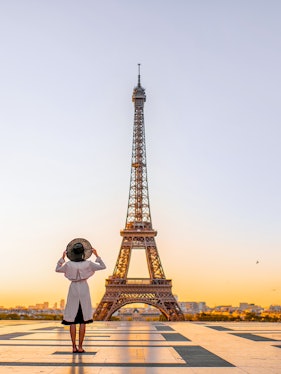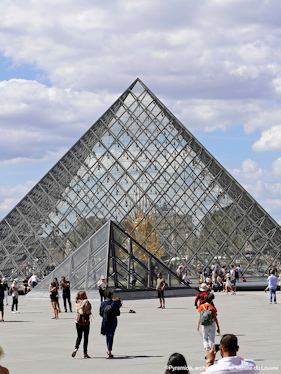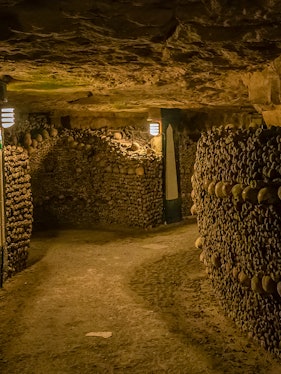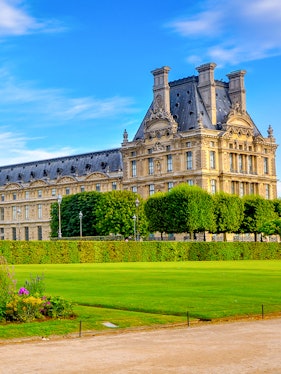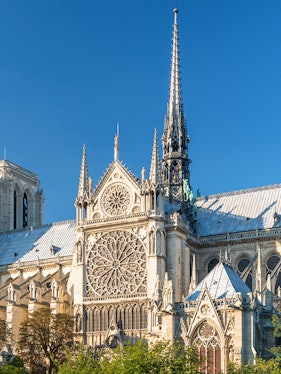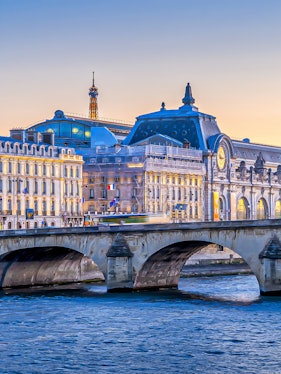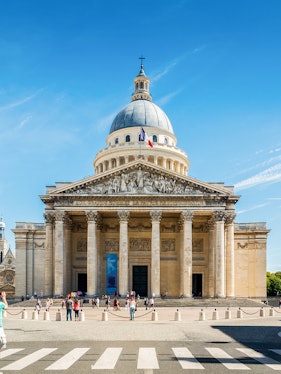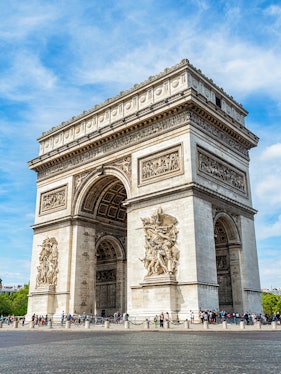Once home to 34 monarchs—from François I to Napoleon—Fontainebleau offers a rare, authentic look into how French royalty lived, ruled, and entertained across centuries.
- Disneyland® Paris Tickets
- Eiffel Tower Tickets
- Louvre Museum Tickets
- Paris Catacombs Tour & Tickets
- Versailles Tickets
- Notre-Dame Paris Tickets
- Orsay Museum Tickets
- Paris Pantheon Tickets
- Arc De Triomphe Tickets
- Opera Garnier Paris Tickets
- Big Bus Paris Hop-on Hop-off Tours
- Parc Astérix Paris Tickets
- Sainte Chapelle Tickets
- Les Invalides Tickets
- Eurail Passes
- Musee de l'Orangerie Tickets
Book Château de Fontainebleau tickets
Make the most of Paris
Why visit Château de Fontainebleau?
700 years of royal history
Explore Château de Fontainebleau
The Grand Apartments
These stately rooms reflect centuries of royal life, from François I to Napoleon. Rich tapestries, gilded woodwork, and coffered ceilings showcase evolving French style and courtly grandeur in spaces used for receptions, ceremonies, and private life.
The Ballroom (Salle de Bal)
Commissioned in the 16th century, this Renaissance hall features a carved wooden ceiling and mythological frescoes by Rosso Fiorentino. It was the stage for royal banquets and courtly performances—elegance designed to impress.
The Throne Room
Converted by Napoleon, this is one of the few surviving throne rooms in France. Deep red drapery, imperial eagles, and the original throne offer a powerful glimpse into the rituals of imperial authority.
The Chapel of the Trinity
This ornate chapel was the site of royal weddings and masses. Its painted ceiling and golden altar, created by Italian artists, highlight the king’s ties to both religion and Renaissance culture.
The Turkish Boudoir
Created for Marie-Antoinette and later used by Empress Josephine, this room mixes Eastern-inspired décor with French luxury—silks, lacquered panels, and rich patterns in a space designed for privacy.
The Courtyards
Each courtyard reflects a chapter of Fontainebleau’s evolution. The Cour d’Honneur served as the formal entrance, while the Cour des Adieux remains historic as the site of Napoleon’s final goodbye in 1814.
The Palace Gardens
From the symmetry of the Grand Parterre to the natural curves of the English Garden, Fontainebleau’s 130 hectares of grounds offer scenic walks, sculptures, and the peaceful Carp Pond for boating or quiet reflection.
The Chinese Museum and Salon
Assembled by Empress Eugénie, this collection of Chinese and Asian artifacts reflects 19th-century fascination with the East—porcelain, lacquerware, and embroidered silks housed in a finely decorated salon.
The Francis I Gallery
A highlight of French Renaissance art, this long corridor features elaborate frescoes and stuccoes by Italian masters, blending mythology and monarchy in a richly detailed visual narrative.
Outdoor activities at Château de Fontainebleau



Plan your visit to Château de Fontainebleau
Chateau
- The chateau is open every day except Tuesday, January 1st, May 1st and December 25th.
- From October to March: 9:30am to 5pm (last access at 4:15pm).
- From April to September: 9:30am to 6pm (last access at 5:15pm).
- The park and gardens are open, under the usual conditions, free of charge.
- The restaurant is open every day for lunch.
- Some spaces may close early. It is recommended to allow 2 hours for a complete self-guided tour of the château.
Courtyards and gardens
- Entry to the courtyards and gardens is free and they are open every day.
- From November to February: 9am-5pm
Last admission: 4pm - In March, April and October: 9am-6pm
Last admission: 5pm - From May to September: 9am-7pm
Last admission: 6pm - The Jardin de Diane and the Jardin Anglais close early, half an hour and one hour respectively before the times indicated.
- The park is open 24 hours a day, 7 days a week.
Address - 77300 Fontainebleau, France Château de Fontainebleau
By train - Take the train from Paris Gare de Lyon (main lines) towards Montargis, Montereau, or Laroche-Migennes, and get off at the Fontainebleau-Avon station.
By car - From Paris, take the A6 (Porte d’Orléans or Porte d’Italie) and take the Fontainebleau exit. Head towards Fontainebleau, and then follow the signs for the ‘château’.
- Toilets: The only indoor toilets in the Chateau are located at the end of the tour.(Other toilets are accessible from the main courtyard to the right of the ticket office.)
- Lockers and cloakroom: Free lockers are available to leave pushchairs, child carriers, bulky bags, umbrellas and other items prohibited during the visit.
Note: For preservation reasons and safety, bulky pushchairs and child carriers are not allowed when visiting the Chateau. Front worn baby slings are available at the cloakroom in addition to buggies. - Changing tables are available in the women’s toilets.
- Pets: Pets are not allowed in the gardens and the courtyards of the Chateau. Service dogs are allowed.
- Lifts: A lift provides access to the Grands Apartments for people with reduced mobility.
- The castle provides free wheelchairs and cane seats in exchange for a piece of ID. They cannot be booked in advance and are distributed directly on site upon request to the reception agents.
- Two parking spaces are at your disposal within the castle grounds. Access is via the Cour des Mathurins (entrance located in Rue Denecourt, across from the municipal theatre).
- You also have the option of being dropped off by car in front of the castle entrance. The vehicle will then have to be parked outside the castle grounds.
- Special toilets are located in the reception areas upon request from staff.
Les Petites Bouches de l’Empereur
- Location: Situated in the château's historic Aile de la Belle Cheminée, near the Porte Dorée.
- Ambiance: Offers a buffet-style dining experience with fresh, seasonal, and locally sourced dishes.
- View: Features a terrace overlooking the Étang aux Carpes and the Grand Parterre designed by André Le Nôtre.
Café des Mariniers
- Location: Located in the Cour de la Fontaine, providing a scenic view of the Étang aux Carpes.
- Offerings: Serves a variety of hot and cold beverages, including coffee in partnership with Café Joyeux, and homemade verrines.
- Accessibility: Open to visitors of the château and gardens; no entry ticket required for access.
Salle des Banquets
- Location: Found within the château, accessible via the Porte Dorée.
- Function: Available for group events, seminars, and other gatherings by reservation.
- Facilities: Equipped with a bar and adjoining catering kitchen, offering a versatile space for various events.
Things to do near Château de Fontainebleau
Fontainebleau Forest
This vast forest offers a natural escape with scenic hiking trails, rock climbing spots, and peaceful picnic areas, making it a perfect complement to the château’s historic grandeur. Its diverse landscapes have inspired artists and nature lovers for centuries.
Barbizon Village
Known as the “Village of Painters,” Barbizon is famous for its 19th-century art colony that attracted masters like Millet and Rousseau. You can explore charming galleries, quaint cafés, and the Barbizon Museum dedicated to this artistic heritage.
Moret-sur-Loing
This medieval town features cobblestone streets, half-timbered houses, and a picturesque riverside setting. It’s a favorite spot for painters like Alfred Sisley and offers a tranquil atmosphere just a short trip from Fontainebleau.
Château de Vaux-le-Vicomte
A masterpiece of 17th-century French architecture and landscaping, this château rivals Fontainebleau with its grand interiors and meticulously designed gardens. It provides insight into the origins of French classical style and inspired Versailles.
Fontainebleau-Avon Train Station
This station connects Fontainebleau to Paris and surrounding towns, making it a convenient starting point or return hub for visitors exploring the region. It’s ideal for those planning day trips or extended stays.
Les Jardins de Diane
Located within the château grounds, these Renaissance gardens offer a serene stroll among fountains, sculptures, and manicured flower beds. They provide a peaceful contrast to the château’s opulent interiors and are perfect for a reflective break.
Musée Napoléon
Housed in the château itself, this museum showcases Napoleon’s legacy through artifacts, portraits, and personal items. It enriches the visit by connecting Fontainebleau’s history to one of France’s most iconic figures.
Place Napoléon
This lively square near the château is lined with cafés and shops, offering a taste of local life and a great spot to relax after touring. It’s a hub for cultural events and a gateway to exploring Fontainebleau’s town center.
Frequently asked questions about Château de Fontainebleau tickets
Yes, the forest is right next to the town and has plenty of walking and cycling paths to explore. Just keep in mind there’s no public transport directly from the château to the forest, so you’ll need to get there on your own.
There are! Admission is free on the first Sunday of each month, except for July and August. You’ll also find free entry during special events like European Museum Night and European Heritage Days.
Out of over 1,500 rooms, only about 120 are open to visitors. Some of the more special apartments and galleries are only accessible with a guide, but you can explore the main Grands Appartements and the Napoleon Museum on your own.
Definitely! There’s a little “Tiny Train” that you can pay for, which takes you on a tour around the gardens—perfect if you want to save your legs.
Yes, there’s the Imperial Theatre, built back in 1857 by Napoleon III and Empress Eugénie. It’s a rare find and usually only open if you join a guided tour.
Try going early in the morning or later in the afternoon on weekdays. Just a heads-up—the château is closed every Tuesday.
You can! It’s not included in the regular ticket though—you’ll need to pay an extra €3, which comes with a cool interactive guide called the HistoPad (for visitors aged 12+). Kids under 12 get in free but won’t get the HistoPad.
Yes, even if your entry is free, guided tours have their own separate fee.
You’re free to explore as long as the château is open. The main route usually takes about 1.5 hours, but if you want to linger longer, that’s totally fine.


